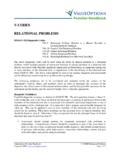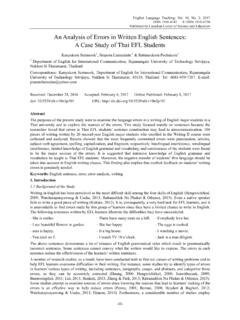Transcription of Effect of Classroom Learning Environment on Students ...
1 Bulletin of Education and Research August 2018, Vol. 40, No. 2 pp. 207-218 Effect of Classroom Learning Environment on Students ' Academic Achievement in Mathematics at Secondary Level Riaz Hussain Malik* and Asad Abbas Rizvi** _____ Abstract The aim of the study was to examine the Effect of the perceptions of Students about Classroom Learning Environment on their academic achievement at secondary level in the Mathematics classrooms. The participants were selected from the secondary and higher secondary schools located in Tehsil Rawalpindi and Islamabad (Federal Area), Pakistan.
2 Twenty four schools were selected randomly. A total of five hundred sixteen Students of 10th grade studying Mathematics in twenty seven classrooms, were included in the sample. Classroom Environment Instrument (Personal Form) was used to measure the Students ' perceptions after translating it into Urdu for Urdu medium schools. The pilot testing was carried out before the actual application of this instrument. The reliability of the instrument was determined by the use of Cronbach Alpha which was found as The marks obtained by Students in the subject of Mathematics in annual examination in 10th grade conducted by both BISE Rawalpindi and FBISE Islamabad were taken as achievements in Mathematics.
3 The data was analyzed using multiple regression, Pearson r and ANOVA to find out the Effect of perception of Students about Classroom Learning Environment on their academic achievement. The results of study revealed that the subscales, `Involvement', `Personal relevance', `Emphasis on understanding', were major predictors contributing towards Classroom Learning Environment and Students ' academic achievement whereas subscales `Investigation' and `Autonomy' have negative Effect on Students ' academic achievement.
4 The researcher recommends that active involvement of the low achievers may affect their Learning more positively. Keywords: Classroom Learning Environment ; Students ' Learning ; Achievement in Mathematics; Understanding; Students ' perception * Assistant Educational Advisor, Curriculum and Text Book Wing, Capital Administration and Development Division. Email: riaz **Assistant Professor, Department of Education International Islamic University Islamabad.
5 Effect of Classroom LE on Students ' AA in Mathematics at Secondary Level 208 Introduction The teaching- Learning process cannot take place in a vacuum. In formal education settings, it occurs as a result of interaction among members of the Classroom . In Classroom settings, elements of teaching- Learning process include: teacher, Students , content, Learning process and Learning situation. The Learning situation or Learning Environment means the conditions in which Learning take place.
6 Each Classroom has unique teaching - Learning conditions. According to Arend (2007), classes may seem similar from the distance but are different in its procedures and the processes. A Classroom setting has two major components, namely, physical component and human component. Physical component comprises all the physical objects present in the Classroom black board, furniture, lightings, projector, books, computers etc., whereas the human component comprises of individuals , teachers and Students in the Classroom .
7 It generally involves the nature of interaction of teachers with Students and student-student as well. This pattern of interaction generates a particular atmosphere which may be called as Learning condition/situation/ Environment . This aspect is also called the psycho-social Environment of the Classroom . Most scholars agree that Students academic achievement varies with Learning conditions. Therefore, this study was designed to investigate the Effect of Students ' perception of Classroom Learning Environment on their academic achievement in mathematics at secondary level.
8 The importance of Mathematics cannot be denied in this age of science and technology. The mathematics knowledge proved to be an essential vehicle to train the minds of the learners to think logically, objectively and reasonably in solving day to day problems. Mathematics is different from other social science subjects because according to Sharan (2006), Mathematics is the study of abstract system which deals with abstract elements. These elements are not described in concrete fashion.
9 The teaching and Learning mathematics requires a proper attitude and deep thinking from the Students in terms of their Learning styles, as well as teacher's knowledge and behavior in the Classroom . It is often said that better Environment of a class helps during group work and hence improve the Learning of the Students . The importance of Environment was derived earlier with the help of concept of `life space' conceived by Randhawa and Lewis (1976). Life space' includes the total psychological field with its entire group of forces, which repels as well as attracts persons in the field.
10 It includes unconscious influence as well as conscious influence, past as well as present influences and has a bearing on the person (including the person as self), is encompassed in the life space, including the behavioral and psychobiological Environment with all of its influences, such as positive and negative goals and the barriers restricting movement toward objectives (Moos & Trickett 1974). Riaz & Asad 209 Murray (1938) introduced the concept of `environmental press'.



















